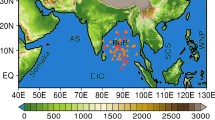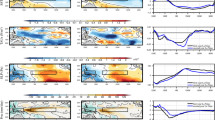Abstract
The impact of the co-variability of sea surface temperature (SST) and vertical wind shear (VWS) on the variability of tropical cyclone (TC) intensity change (ΔV, defined as 24-h intensity change) in the northern hemisphere (NH) is discussed from both interannual and long-term time scales based on the maximum covariance analysis (MCA) and trend analysis, respectively. It is found that the coupling feature in the co-variability of SST and VWS clearly modulates the relationship between the regional variability of TC intensity change and that of SST and VWS. From an interannual time scale, the variability of TC ΔV and intensification rate (IR, ΔV for records with ΔV > 0) is highly correlated with the co-variability of SST and VWS in regions where SST and VWS move together in a direction that favors (inhibits) TC development, while the relationship involves greater uncertainty in regions where SST and VWS move in an opposite direction in affecting TC intensity change. From a long-term aspect, the coupling feature of SST and VWS trends also show modulation on regional differences in ΔV and IR trends. Specifically, although the ΔV and IR of NH TCs are expected to increase under global warming, their trends are obviously more pronounced for TCs in areas where warming SST trends are accompanied by decreasing VWS trends. Our findings highlight the importance of considering the co-variability of SST and VWS in interpreting the climate variability of TC intensity change.








Similar content being viewed by others
Data availability
The IBTrACs dataset can be found at https://www.ncdc.noaa.gov/ibtracs/. The ERA-5 reanalysis data can be found at https://cds.climate.copernicus.eu/cdsapp#!/dataset/reanalysis-era5-pressure-levels-monthly-means?tab=overview. The Met-Office Hadley Centre SST (HadISST) is available at https://www.metoffice.gov.uk/hadobs/hadisst/data/download.html.
Change history
25 January 2024
A Correction to this paper has been published: https://doi.org/10.1007/s00382-024-07106-4
References
Aiyyer A, Thorncroft C (2011) Interannual-to-multidecadal variability of vertical shear and tropical cyclone activity. J Clim 24(12):2949–2962
Bhatia K, Baker A, Yang W et al (2022) A potential explanation for the global increase in tropical cyclone rapid intensification. Nat Commun 13:6626. https://doi.org/10.1038/s41467-022-34321-6
Bhatia K, Vecchi G, Murakami H, Underwood S, Kossin J (2018) Projected response of tropical cyclone intensity and intensification in a global climate model. J Clim 31(20):8281–8303
Bhatia KT, Vecchi GA, Knutson TR, Murakami H, Kossin J, Dixon KW, Whitlock CE (2019) Recent increases in tropical cyclone intensification rates. Nat Commun 10:1–9
Bretherton CS, Smith C, Wallace JM (1992) An intercomparison of methods for finding coupled patterns in climate data. J Clim 5:541–560
Cai W, Wu L, Lengaigne M, Li T, McGregor S, Kug JS, Yu JY, Stuecker MF, Santoso A, Li X, Ham YG (2019) Pantropical climate interactions. Science 363(6430):eaav4236
Camargo SJ, Sobel AH (2005) Western North Pacific tropical cyclone intensity and ENSO. J Clim 18:2996–3006
Camargo SJ, Robertson AW, Gaffney SJ, Smyth P, Ghil M (2007) Cluster analysis of typhoon tracks: Part II: Large-scale circulation and ENSO. J Clim 20:3654–3676
Chan JCL, Duan YH, Shay LK (2001) Tropical cyclone intensity change from a simple ocean–atmosphere coupled model. J Atmos Sci 58:154–172
Colbert AJ, Soden BJ, Kirtman BP (2015) The impact of natural and anthropogenic climate change on western North Pacific tropical cyclone tracks. J Clim 28:1806–1823
Dai A (2013) Increasing drought under global warming in observations and models. Nat Clim Change 3:52–58
Emanuel KA (1986) An air-sea interaction for tropical cyclones. Part I: steady-state maintenance. J Atmos Sci 43:585–604
Emanuel KA (2007) Environmental factors affecting tropical cyclone power dissipation. J Clim 20:5497–5509
Evan A, Kossin JP, Chung CE, Ramanathan V (2011) Arabian Sea tropical cyclones intensified by emissions of black carbon and other aerosols. Nature 479:94–97
Frank WM, Ritchie EA (2001) Effects of vertical wind shear on the intensity and structure of numerically simulated hurricanes. Mon Weather Rev 129:2249–2269
Gallina G, Velden C (2002) Environmental vertical wind shear and tropical cyclone intensity change utilizing enhanced satellite derived wind information. Preprints, 25th Conf. on Hurricanes and Tropical Meteorology, San Diego, CA, Amer. Meteor. Soc., p. 172–173
Gastineau G, Frankignoul C (2015) Influence of the North Atlantic SST variability on the atmospheric circulation during the twentieth century. J Clim 28(4):1396–1416
Goldenberg SB, Landsea CW, Mestas-Nunez AM, Gray WM (2001) The recent increase in Atlantic hurricane activity: causes and implications. Science 293:474–479
Gray MW (1968) Global view of the origin of tropical disturbances and storms. Mon Weather Rev 96:669–700
Gray MW (1978) Hurricanes: their formation, structure and likely role in the tropical circulation. In: Shaw DB (ed) Meteorology over the tropical oceans. Royal Meteorological Society. James Glaisher House, Bracknell, pp 127–139
Gu J-F, Tan Z-M, Qiu X (2016) Quadrant-dependent evolution of low-level tangential wind of a tropical cyclone in the shear flow. J Atmos Sci 73:1159–1177
Gu J-F, Tan Z-M, Qiu X (2018) The evolution of vortex tilt and upward motion of tropical cyclones in directional shear flows. J Atmos Sci 75:3565–3578
Guo Y-P, Tan Z-M (2018) Westward migration of tropical cyclone rapid-intensification over the Northwestern Pacific during short duration El Niño. Nat Commun 9:1507
Guo Y-P, Tan ZM (2018) Impacts of the boreal spring Indo-Pacific warm pool Hadley circulation on tropical cyclone activity over the western North Pacific. J Clim 31:1361–1375
Kaplan J, DeMaria M (2003) Large-scale characteristics of rapidly intensifying tropical cyclones in the north Atlantic basin. Weather Forecast 18:1093–1108
Kaplan J et al (2015) Evaluating environmental impacts on tropical cyclone rapid intensification predictability utilizing statistical models. Weather Forecast 30:1374–1396
Kim H, Webster PJ, Curry JA (2011) Modulation of North Pacific tropical cyclone activity by three phases of ENSO. J Clim 24(6):1839–1849
Klotzbach PJ (2012) El Niño-Southern Oscillation, the Madden–Julian Oscillation and Atlantic basin tropical cyclone rapid intensification. J Geophys Res 117:D14104
Klotzbach P et al (2022) Trends in global tropical cyclone activity: 1990–2021. Geophys Res Lett 49:e2021GL095774
Knutson TR et al (2010) Tropical cyclones and climate change. Nat Geosci 3:157–163
Kossin JP (2017) Hurricane intensification along United States coast suppressed during active hurricane periods. Nature 541:390–393
Kossin JP, Vimont DJ (2007) A more general framework for understanding Atlantic hurricane variability and trends. Bull Am Meteor Soc 88:1767–1781
Kossin JP, Olander TL, Knapp KR (2013) Trend analysis with a new global record of tropical cyclone intensity. J Clim 26:9960–9976
Kossin JP, Knapp KR, Olander TL, Velden CS (2020) Global increase in major tropical cyclone exceedance probability over the past four decades. Proc Natl Acad Sci USA 117:11975–11980
Kumar A, Zhang Q, Peng P, Jha B (2005) SST-forced atmospheric variability in an atmospheric general circulation model. J Clim 18:3953–3967
Lau N-C (1997) Interactions between Global SST anomalies and the midlatitude atmospheric circulation. Bull Am Meteor Soc 78:21–33
Liu KS, Chan JCL (2013) Inactive period of western North Pacific tropical cyclone activity in 1998–2011. J Clim 26(8):2614–2630
Lu J, Vecchi GA, Reichler T (2007) Expansion of the Hadley cell under global warming. Geophys Res Lett 34:L06805
Malkus JS, Riehl H (1960) On the dynamics and energy transformation in steady-state hurricanes. Tellus 12:1–20
Maloney ED, Hartmann DL (2000) Modulation of eastern North Pacific hurricanes by the Madden-Julian Oscillation. J Clim 13:1451–1460
Miller BI (1958) On the maximum intensity of hurricanes. J Meteor 15:184–195
Montgomery MT, Snell HD, Yang Z (2001) Axisymmetric spindown dynamics of hurricane-like vortices. J Atmos Sci 58(5):421–435
Palmén E (1948) On the formation and structure of tropical hurricanes. Geophysica 3:26–38
Rappaport E, Franklin J, Schumacher A, DeMaria M, Shay L, Gibney E (2010) Tropical cyclone intensity change before US Gulf Coast landfall. Weather Forecast 25:1380–1396
Sharmila S, Walsh KJE (2017) Impact of large-scale dynamic versus thermodynamic climate conditions on contrasting tropical cyclone genesis frequency. J Clim 30:8865–8883
Tang B, Emanuel K (2012) A ventilation index for tropical cyclones. Bull Am Meteor Soc 93:1901–1912
Ting M, Kossin JP, Camargo SJ, Li C (2019) Past and future hurricane intensity change along the US East Coast. Sci Rep 9:7795
Vecchi GA, Soden BJ (2007) Global warming and the weakening of the tropical circulation. J Clim 20:4316–4340
von Storch H, Zwiers FW (1999) Statistical analysis in climate research. Cambridge University Press, Cambridge
Walsh KJE, McBride JL, Klotzbach PJ, Balachandran S, Camargo SJ, Holland G, Knutson TR, Kossin JP, Lee T-, Sobel A, Sugi M (2016) Tropical cyclones and climate change. WIREs Clim Change 7:65–89
Wang Y (2012) Recent research progress on tropical cyclone structure and intensity. Trop Cyclone Res Rev 1:254–275
Wang C, Lee S-K (2009) Co-variability of tropical cyclones in the North Atlantic and the eastern North Pacific. Geophys Res Lett 36:L24702
Wang X, Wang C, Zhang L, Wang X (2015) Multidecadal variability of tropical cyclone rapid intensification in the Western North Pacific. J Clim 28(9):3806–3820
Webster PJ, Holland GJ, Curry JA, Chang HR (2005) Changes in tropical cyclone number, duration and intensity in a warming environment. Science 309:1844–1846
Wu Q, Wang X, Tao L (2020) Interannual and interdecadal impact of Western North Pacific Subtropical High on tropical cyclone activity. Clim Dyn 54:2237–2248
Xu J, Wang Y (2018) Dependence of tropical cyclone intensification rate on sea surface temperature storm intensity, and size in the western North Pacific. Weather Forecast 33(2):523–537
Xu J, Wang Y (2022) Potential intensification rate of tropical cyclones in a simplified energetically based dynamical system model: An observational analysis. J Atmos Sci 79(4):1045–1055
Zeng Z, Wang Y, Wu C (2007) Environmental dynamical control of tropical cyclone intensity—an observational study. Mon Weather Rev. 135(1):38–59
Zhang G, Wang G (2015) Interannual variability of tropical cyclone activity and regional Hadley circulation over the northeastern Pacific. Geophys Res Lett 42:2473–2481
Zhao H, Duan X, Raga GB, Klotzbach PJ (2018) Changes in characteristics of rapidly intensifying western north pacific tropical cyclones related to climate regime shifts. J Clim 31(19):8163–8179
Zhu X, Saravanan R, Chang P (2012) Influence of mean flow on the ENSO–vertical wind shear relationship over the northern tropical Atlantic. J Clim 25:858–864
Acknowledgments
We thank all the reviewers for their valuable suggestions.
Funding
This research was jointly supported by the National Natural Science Foundation of China (42375012, 42192555).
Author information
Authors and Affiliations
Contributions
Xi. Guo performed the data analyses and wrote the main manuscript, J. Kossin and Z.-M. Tan contributed to the conception of the study and reviewed and edited the manuscript.
Corresponding author
Ethics declarations
Conflict of interest
The authors declare they have no competing interests.
Additional information
Publisher's Note
Springer Nature remains neutral with regard to jurisdictional claims in published maps and institutional affiliations.
The original online version of this article was revised: " In this article the affiliation details for Author Xi Guo and Zhe-Min Tan has been swapped.
Supplementary Information
Below is the link to the electronic supplementary material.
Rights and permissions
Springer Nature or its licensor (e.g. a society or other partner) holds exclusive rights to this article under a publishing agreement with the author(s) or other rightsholder(s); author self-archiving of the accepted manuscript version of this article is solely governed by the terms of such publishing agreement and applicable law.
About this article
Cite this article
Guo, X., Kossin, J.P. & Tan, ZM. The co-variability of SST and vertical wind shear on the variability of tropical cyclone intensity change in the Northern Hemisphere. Clim Dyn 62, 2581–2594 (2024). https://doi.org/10.1007/s00382-023-07049-2
Received:
Accepted:
Published:
Issue Date:
DOI: https://doi.org/10.1007/s00382-023-07049-2




